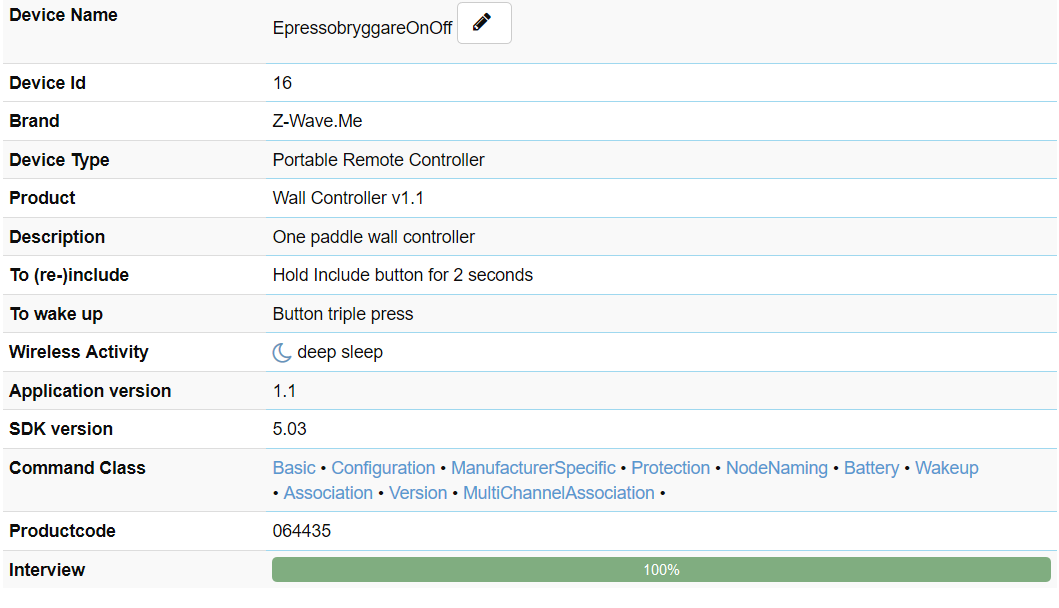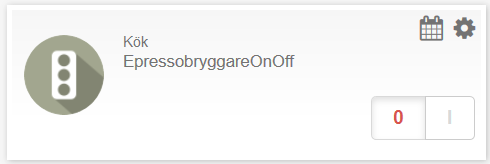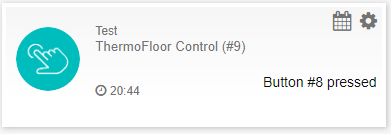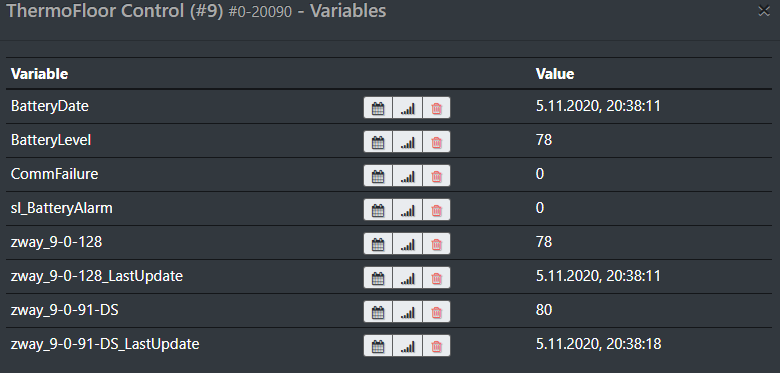@akbooer
Since a couple of weeks/months, we are in the process to redo 5 rooms @ home (kids are moving from room to another room) and of course, I would need to redo a bunch of device name and room name in Zway..
Is there an easy way to tell openLuup to completely start over fresh without having to delete/rename them one by one in openLuup ?
I hope this is the correct forum – apologies if not!
I have a Raspberry Pi3 with a Razberry Z-Wave card installed. I have installed the Z-Way software and have successfully included a Fibaro Z-Wave switch on the Z-Wave network. I can toggle the switch on and off successfully from my laptop through port 8083 of the Raspberry Pi3.
On the same Raspberry Pi3 I have installed openLuup on which I have installed the Z-Way plugin. I can access this through port 3480 on the Raspberry Pi3 from my laptop.
Here is where I have come to a dead stop. How do I get access to the Fibaro Z-Wave switch from the openLuup application? I can find no documentation that tells me specifically how to do this.
Any help would be greatly appreciated.
_John.
I have an odd issue which seems to be only for Fibaro wall plugs. They come in to Z-Way with two "electric meter" entrys, one "Power" meter and a couple of alarm entrys. In addition to the switch that is.
One of the "electric meters" is KWh and the other one is seemingly Watts, but it stays at 0/-1w. The "Power" meter shows the Watts used right now.
When these come into openluup, the wrong electric meter is selected for displaying the Watts, is there any way to manipulate which one openLuup uses? I see that the sub channel for power also is transferred, but it isn't in the data Veraflux is transmitting to my influxdb..
Haven't used the watts reading for anything before now, now i want to estimate when my dryer is done based on power usage.
Having some trouble getting the Fibaro TRV device working with the ZWay bridge. The device works in the ZWay (Zwave.Me) Smart Home GUI, and creates a number of devices in OpenLuup, some of which appear to have the right variables in it. Changing the XML and JSON files makes no difference.
I also tried creating a separate child device for Parameter 67 (using the gui for the ZWay bridge, see below), and setting the XML/JSON types for that device (like I've havd to do for a few other devices). This results in a device that correctly displays the TRV setpoint, but chaning the setpoint in the OpenLuup gui does not result in anything being transmitted to/by ZWay.
20490 49-0 D_ComboDevice1.xml zNode #49-0
49-0-113-8-12-A
49-0-113-8-13-A
49-0-113-8-14-A
49-0-113-8-15-A
49-0-113-9-3-A
49-0-64
49-0-67-1
20491 49-1 D_ComboDevice1.xml zNode #49-1
49-1-113-8-12-A
49-1-113-8-13-A
49-1-113-8-14-A
49-1-113-8-15-A
49-1-113-9-3-A
49-1-64
25031 49-1-67-1 D_Heater1.xml Radiator Bedroom
20492 49-2 D_ComboDevice1.xml multi #49-2
49-2-113-8-10-A
49-2-113-8-11-A
25030 49-2-49-1 D_TemperatureSensor1.xml Radiator Bedroom
Nearly there with the migration ..
Is it ok to use older device files or do they get updated from time to time?
Now that a fresh openLuup is up and running and connected to Zway where's the best place to source device files without vera? I probably have them on another openLuup install but not 100% which ones to copy over.
I've finally gotten the stuff to work together. Now - before I migrate all the vera devices, how do i use this?
How does the variables NameDevices and CloneRooms work? (is there a manual or description of the plugin?)
CloneRooms seems obvious, but is that the best way to go when I have more bridges?
Set up rooms and names in Z-way?
No rooms in z-way, and distribute them in openluup?
Hi AK,
I must be missing something but I am having now some devices fail on the bridge due to them running out of battery. Upon battery replacement, they function properly on z-way-server but the failure remains over the bridge. The failure shows up on the parent device and it says that a specific command class has failed. Looking at the return API json, it should not return any command class level failure however so I am not sure where the bridge gets its failed state from...
edit: Nevermind, I figured it out. It is a gap in data alignment between the different z-way APIs. The zwave and JS API got the update that the device recovered but not the smarthome API. Pausing and restarting the zwave app on z-way fixed it.
I noticed the change when I switched from the RaZberry to UZB (During the switch all devices moved to the Room 101 briefly, maybe that had something to do with it). Any idea why this would have happened? Can I easily change them all back to enabled? Also, what exactly does this attribute do? I only noticed because none of my z-wave devices were showing up in Imperihome and when I set the "disabled" attribute back to 0, the device shows up. Thanks.
So I started experimenting by moving some of my wallplugs and power switch zwave devices over from VeraPlus to Z-Way.
In Z-Way this results in different elements for switching, Watts and kWh. Some even have Volts which I never saw on Vera.
But using the Z-Way plugin in openLuup only the Switch element is visible and all other elements of the zwave node are not.
I don't really know to much about Z-Way or the plugin, but am trying to learn on the run.
Maybe someone can give me some pointers what and where to look for to solve this?
Just wanted to point out and start the topic of the following:
We are working on a project that will allow to use Z-Way library as the core of Z-Wave in Home Assistant. First releases will be around June/July I believe
Additionally there are ways to support Z-Way from HAss via HTTP requests. This is a community project and we have no deep knowledge about it.
С уважением,
Полторак Сергей
Z-Wave.Me
https://community.home-assistant.io/t/official-z-way-integration-request/186710/27
Changing device type for wall controller
Zway Bridge
25
Posts
5
Posters
7.0k
Views
5
Watching








